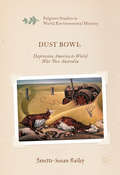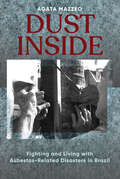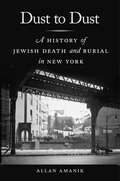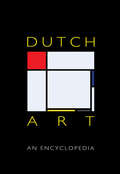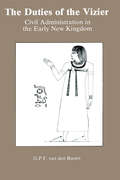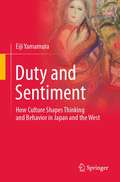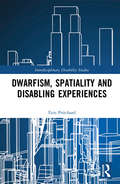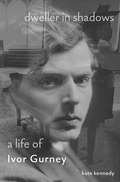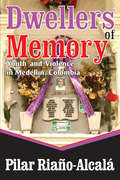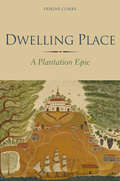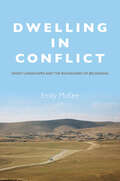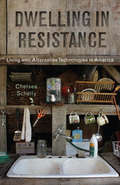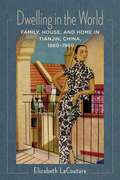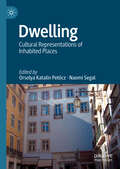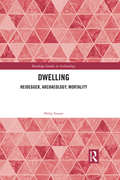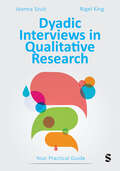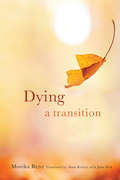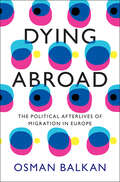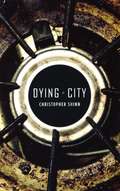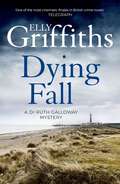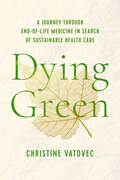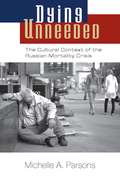- Table View
- List View
Dust Bowl: Depression America to World War Two Australia (Palgrave Studies in World Environmental History)
by Janette-Susan BaileyThis book takes the Dust Bowl story beyond Depression America to describe the ‘dust bowl’ concept as a transnational phenomenon, where during World War Two, US and Australian national mythologies converged. Dust Bowl begins with Depression America, the New Deal and the US Dust Bowl where massive dust storms darkened the skies of the Great Plains and triggered a major national and international media event and generated imagery describing a failed yeoman dream, Dust Bowl refugees, and the coming of a new American Desert. Dust Bowl traces the evolution of this imagery to Australia, World War Two and New Deal-inspired stories of conservation-mindedness, soil erosion and enemies, sheep-farmers and traitors, creeping deserts and human extinction, super-human housewives and natural disaster and finally, grand visions of a nation-building post-war scheme for Australia’s iconic Snowy River‒that vision became the Snowy Mountains Hydro-electric Scheme.
Dust Inside: Fighting and Living with Asbestos-Related Disasters in Brazil
by Agata MazzeoToxic production, disrupted lives and contaminated bodies. Care for unacknowledged suffering, incurable cancers, and immeasurable losses. This book bears witness to the invisible disasters provoked by the asbestos market worldwide and gives a voice to the communities of survivors who struggle daily in the name of social and environmental justice. Grounded in a profound, touching ethnography, this book offers an original contribution to understanding global health disasters and grassroots health-based activism.
Dust to Dust: A History of Jewish Death and Burial in New York (Goldstein-Goren Series in American Jewish History #7)
by Allan AmanikA revealing look at how death and burial practices influence the livingDust to Dust offers a three-hundred-year history of Jewish life in New York, literally from the ground up. Taking Jewish cemeteries as its subject matter, it follows the ways that Jewish New Yorkers have planned for death and burial from their earliest arrival in New Amsterdam to the twentieth century.Allan Amanik charts a remarkable reciprocity among Jewish funerary provisions and the workings of family and communal life, tracing how financial and family concerns in death came to equal earlier priorities rooted in tradition and communal cohesion. At the same time, he shows how shifting emphases in death gave average Jewish families the ability to advocate for greater protections and entitlements such as widows’ benefits and funeral insurance. Amanik ultimately concludes that planning for life’s end helps to shape social systems in ways that often go unrecognized.
Dutch Art: An Encyclopedia
by Sheila D. MullerAn illustrated feast for the eye and intellect Dutch Art explores developments in art, art history, art criticism, and cultural history of the Netherlands from the artists' workshops for the Utrecht Dom in 1475 to the latest movements of the 1990s. it is lavishly illustrated with 147 black-and-white photographs and 16 pages in full color. More than 100 internationally recognized scholars, museum professionals, artists, and art critics contributed signed essays to this monumental work, including historians, sociologists, and literary historians.
Duties Of The Vizier: Civil Administration in the Early New Kingdom
by G. P. Van Den BoornFirst Published in 1988. Routledge is an imprint of Taylor & Francis, an informa company.
Duty and Sentiment: How Culture Shapes Thinking and Behavior in Japan and the West
by Eiji YamamuraThis book is an exploration that shows us how sentiment and duty form the core of Japanese culture. It looks at how the combination of common sense, culture, and social norms influence people’s ways of thinking and behavior. Although the focus is Japan in looking at these interrelationships, the author draws on his experience and knowledge of other countries from his days before graduate school, when he traveled the world as a backpacker. Now, from the world of academia, he uses his knowledge of economic analysis to consider the similarities and differences in human behavior among countries and cultures. The wide-ranging scope of the book takes in marital life, education, sports, business, and culture in modern Japanese society. Why, for instance, does linguistic heterogeneity generally have negative effects on FIFA rankings of national soccer teams, and what does this have to do with the difficulty of technology transfer among businesses in multilingual countries? Why was the demand for the film Bohemian Rhapsody, about the British rock group Queen, so high in Japan? How do Kazuo Ishiguro’s novels resemble scenarios related to Japan’s long-term public finance prospects? How does the depiction of contemporary life compared with “the old days” in the films of Yasujiro Ozu provide a cautionary tale for aging societies today? How are older people with grandchildren more likely to accept tax increases to support future generations? And how is the Japanese government actively drawing on behavioral economics to appeal to public sentiment to contain the spread of COVID-19. These and a multitude of other questions are tackled by the backpacker who entered academia to become an economist and who now goes on a journey to find the answers. Readers can take the trip with him under his expert guidance, as he artfully combines sentiment, duty, and economic analysis.
Duty of Care for Learning Disability Workers
by Justine Barksby Lucy HarperIf you are working within the learning disability sector and studying for the QCF Diploma in Health and Social Care, you will find this book invaluable in helping you to achieve the unit on Duty of Care. It will help you to understand how duty of care affects the people you support, their family carers, you and your employer. The book is easy to navigate, with each chapter covering one of the learning outcomes within the unit. Each chapter begins with an example taken from real people's stories and lots of activities, photographs and other illustrations are included throughout.
Dwarfism, Spatiality and Disabling Experiences (Interdisciplinary Disability Studies)
by Erin PritchardThis book provides an in-depth analysis of the social and spatial experiences of people with dwarfism, an impairment that results in a person being no taller than 4ft 10. This book engages with the concept that dwarfism’s most prominent feature – body size and shape – can form the basis of social discrimination and disadvantages within society. By ignoring body size as a disability, it is hard to see the resulting disabling consequences of the built environment. Using a mixed-methods approach and drawing on the work undertaken by human geographers and disability studies academics, this book analyses how the relationship between harmful cultural stereotypes and space shapes everyday experiences of people with dwarfism and works to socially exclude them in diverse ways. Showing how spatial and social barriers are not mutually exclusive but can influence one another, this book responds to the limited academic work on the subject of dwarfism, whilst also contributing to the study of geographies of body size. It will be of interest to all scholars and students of disability studies, human geography, the built environment, sociology and medical humanities.
Dweller in Shadows: A Life of Ivor Gurney
by Kate KennedyThe first comprehensive biography of an extraordinary English poet and composer whose life was haunted by fighting in the First World War and, later, confinement in a mental asylumIvor Gurney (1890–1937) wrote some of the most anthologized poems of the First World War and composed some of the greatest works in the English song repertoire, such as “Sleep.” Yet his life was shadowed by the trauma of the war and mental illness, and he spent his last fifteen years confined to a mental asylum. In Dweller in Shadows, Kate Kennedy presents the first comprehensive biography of this extraordinary and misunderstood artist.A promising student at the Royal College of Music, Gurney enlisted as a private with the Gloucestershire regiment in 1915 and spent two years in the trenches of the Western Front. Wounded in the arm and subsequently gassed during the Battle of Passchendaele, Gurney was recovering in hospital when his first collection of poems, Severn and Somme, was published. Despite episodes of depression, he resumed his music studies after the war until he was committed to an asylum in 1922. At times believing he was Shakespeare and that the “machines under the floor” were torturing him, he nevertheless continued to write and compose, leaving behind a vast body of unpublished work when he died of tuberculosis. Drawing on extensive archival research and spanning literary criticism, history, psychiatry and musicology, this compelling narrative sets Gurney’s life and work against the backdrop of the war and his institutionalisation, probing the links between madness, suffering and creativity.Facing death in the trenches, Gurney hoped that history might not “forget me quite.” This definitive account of his life and work helps ensure that he will indeed be remembered.
Dwellers of Memory: Youth and Violence in Medellin, Colombia
by Pilar Riano-AlcalaDwellers of Memory is an ethnographic study of how urban youth in Colombia came to be at the intersection of multiple forms of political, drug-related, and territorial violence in a country undergoing forty years of internal armed conflict. It examines the ways in which youth in the city of Medellin reconfigure their lives and, cultural worlds in the face of widespread violence. This violence has transgressed familiar boundaries and destroyed basic social supports and networks of trust. This volume attempts to map and understand its patterns and flows.The author explores how Medellin's youth locate themselves and make, sense of violence through contradictory and shifting memory practices. The violence has not completely taken over their cultural worlds or their subjectivities. Practices of remembering and forgetting are key methods by which these youth rework their identities and make sense of the impact of violence on their lives. While the experience of violence is rooted in urban space and urban youth, the memory dwellers use a sense of place, oral histories of death, and narratives of fear as survival strategies for inhabiting violent neighborhoods. The book also examines fissures in memory, the contradictory constructions of young people's subjective selves, and practices of gendered violence and terror. All have and continue to pose risks to the historical memory and cultural survival of the residents of Medellin.Dwellers of Memory offers an alternative ethnographic approach to the study of memory and violence, one that calls into question whether the, role of the ethnographer of violence is to be a mere witness of terror, or to oppose it by writing against it. It will be of interest to sociologists, anthropologists, and students of, ethnography.
Dwelling Place: A Plantation Epic
by Erskine ClarkeWinner of the Bancroft Prize. &“[A] beautifully conceived and penetrating book . . . one of the finest studies of American slavery ever written.&”—The New Republic Published some thirty years ago, Robert Manson Myers&’s Children of Pride: The True Story of Georgia and the Civil War won the National Book Award in history and went on to become a classic reference on America&’s slaveholding South. That book presented the letters of the prominent Presbyterian minister and plantation patriarch Charles Colcock Jones (1804–1863), whose family owned more than one hundred slaves. While extensive, these letters can provide only one part of the story of the Jones family plantations in coastal Georgia. In this remarkable new book, the religious historian Erskine Clarke completes the story, offering a narrative history of four generations of the plantations&’ inhabitants, white and black. Encompassing the years 1805 to 1869, Dwelling Place: A Plantation Epic describes the simultaneous but vastly different experiences of slave and slave owner. This &“upstairsdownstairs&” history reveals in detail how the benevolent impulses of Jones and his family became ideological supports for deep oppression, and how the slave Lizzy Jones and members of her family struggled against that oppression. Through letters, plantation and church records, court documents, slave narratives, archaeological findings, and the memory of the African American community, Clarke brings to light the long-suppressed history of the slaves of the Jones plantations—a history inseparably bound to that of their white owners. &“Clarke&’s magisterial, multiperspective study of the antebellum South describes two family groups . . . a &‘total&’ history of interconnected people divided by race, legal status, and gender.&”—Choice
Dwelling in Conflict
by Emily MckeeLand disputes in Israel are most commonly described as stand-offs between distinct groups of Arabs and Jews. In Israel's southern region, the Negev, Jewish and Bedouin Arab citizens and governmental bodies contest access to land for farming, homes, and industry and struggle over the status of unrecognized Bedouin villages. "Natural," immutable divisions, both in space and between people, are too frequently assumed within these struggles. Dwelling in Conflict offers the first study of land conflict and environment based on extensive fieldwork within both Arab and Jewish settings. It explores planned towns for Jews and for Bedouin Arabs, unrecognized villages, and single-family farmsteads, as well as Knesset hearings, media coverage, and activist projects. Emily McKee sensitively portrays the impact that dividing lines--both physical and social--have on residents. She investigates the political charge of people's everyday interactions with their environments and the ways in which basic understandings of people and "their" landscapes drive political developments. While recognizing deep divisions, McKee also takes seriously the social projects that residents engage in to soften and challenge socio-environmental boundaries. Ultimately, Dwelling in Conflict highlights opportunities for boundary crossings, revealing both contemporary segregation and the possible mutability of these dividing lines in the future.
Dwelling in Resistance: Living with Alternative Technologies in America
by Chelsea SchellyMost Americans take for granted much of what is materially involved in the daily rituals of dwelling. In Dwelling in Resistance, Chelsea Schelly examines four alternative U.S. communities—“The Farm,” “Twin Oaks,” “Dancing Rabbit,” and “Earthships”—where electricity, water, heat, waste, food, and transportation practices differ markedly from those of the vast majority of Americans. Schelly portrays a wide range of residential living alternatives utilizing renewable, small-scale, de-centralized technologies. These technologies considerably change how individuals and communities interact with the material world, their natural environment, and one another. Using in depth interviews and compelling ethnographic observations, the book offers an insightful look at different communities’ practices and principles and their successful endeavors in sustainability and self-sufficiency.
Dwelling in the World: Family, House, and Home in Tianjin, China, 1860–1960 (Studies of the Weatherhead East Asian Institute, Columbia University)
by Elizabeth LaCoutureBy the early twentieth century, Chinese residents of the northern treaty-port city of Tianjin were dwelling in the world. Divided by nine foreign concessions, Tianjin was one of the world’s most colonized and cosmopolitan cities. Residents could circle the globe in an afternoon, strolling from a Chinese courtyard house through a Japanese garden past a French Beaux-Arts bank to dine at a German café and fall asleep in a British garden city-style semi-attached brick house.Dwelling in the World considers family, house, and home in Tianjin to explore how tempos and structures of everyday life changed with the fall of the Qing Empire and the rise of a colonized city. Elizabeth LaCouture argues that the intimate ideas and practices of the modern home were more important in shaping the gender and status identities of Tianjin’s urban elites than the new public ideology of the nation. Placing the Chinese home in a global context, she challenges Euro-American historical notions that the private sphere emerged from industrialization. She argues that concepts of individual property rights that emerged during the Republican era became foundational to state-society relations in early Communist housing reforms and in today’s middle-class real estate boom.Drawing on diverse sources from municipal archives, women’s magazines, and architectural field work to social surveys and colonial records, Dwelling in the World recasts Chinese social and cultural history, offering new perspectives on gender and class, colonialism and empire, visual and material culture, and technology and everyday life.
Dwelling: Cultural Representations of Inhabited Places
by Naomi Segal Orsolya Katalin PetőczDwelling is both an action and a location; it combines the spatial idea of habitation (dwelling in) with the temporal idea of lingering (dwelling on). We live not only in bricks and mortar, a tent, a hut or a spaceship, but also in that most changeful of forms, our body, or in a remembered or virtual home. Especially since COVID-19 we have seen changes in the topography of everyday life. In this multi-disciplinary collection, a complex of meanings is approached from a variety of specific, often personal angles.Framed by two longer essays which theorise how the psychology of home may change under sudden pressure and how social relations are embodied in windows, doors, walls and stairs, the book includes 18 further essays. Part I, ‘Informal settlements’, shows how a slum, urban development or nomadic life may create a self-sustaining identity; in Part II, ‘Huts and bridges’, impermanence shapes the state of dwelling, while Part III, ‘Liminal bodies’, presents bodies suspended at thresholds of change. Movement in time and space characterises the last three sections: Part IV, ‘Moving home’, depicts transitions and arrivals, Part V, ‘Dwelling in Memory’, focuses on recollections of past places and Part VI, ‘Are we there yet?’, points the way to a future in which the consulting-room changes to 2D, a family is exiled onto the small screen or we imagine breaking away altogether into outer space.
Dwelling: Heidegger, Archaeology, Mortality (Routledge Studies in Archaeology)
by Philip TonnerDwelling: Heidegger, Archaeology, Mortality negotiates the discourses of phenomenology, archaeology and palaeoanthropology in order to extend the ‘dwelling perspective’, an approach in the social sciences particularly associated with Tim Ingold and a number of other thinkers, including Chris Tilley, Julian Thomas, Chris Gosden and Clive Gamble, that developed out of an engagement with the thought of Martin Heidegger. This unique book deals with Heidegger’s philosophy as it has been explored in archaeology and anthropology, seeking to expand its cross-disciplinary engagement into accounts of early humans and death awareness. Tonner reads Heidegger’s thought of dwelling in connection to recent developments in the archaeology of mortuary practice amongst our ancestors. Agreeing with Heidegger that an awareness of death marks out a distinctive way of ‘being-in-the-world’, Tonner rejects any relict anthropocentrism in Heidegger’s thought and seeks to break down simple divisions between humans and pre-humans. This book is ideal for readers wishing to cross disciplinary boundaries and to challenge anthropocentric thinking in accounts of human evolution. It would be ideal for professional researchers in the fields covered by the book as well as for graduate students and advanced undergraduates.
Dyadic Interviews in Qualitative Research: Your Practical Guide
by Joanna Szulc Nigel KingFrom world-class qualitative experts comes a practical, step-by-step introduction to doing dyadic interviews. Including the perspective of both the interviewer and the interviewee, this book shows how to use this innovative interview technique to gain new insights into your research problem. The book will also equip you with the tools and confidence to overcome potential challenges associated with the method and fully realise its advantages. The book includes: · Real world interview extracts so you can see how techniques work in practice · Case studies from a wide range of disciplines and contexts · A researcher’s checklist with step-by-step guidance through the whole research process · Content covering digital methods as well as in-person interviews. This is the definitive roadmap for conducting dyadic interviews for students and researchers doing qualitative research across the social sciences.
Dyadic Interviews in Qualitative Research: Your Practical Guide
by Nigel King Joanna SzulcFrom world-class qualitative experts comes a practical, step-by-step introduction to doing dyadic interviews. Including the perspective of both the interviewer and the interviewee, this book shows how to use this innovative interview technique to gain new insights into your research problem. The book will also equip you with the tools and confidence to overcome potential challenges associated with the method and fully realise its advantages. The book includes: · Real world interview extracts so you can see how techniques work in practice · Case studies from a wide range of disciplines and contexts · A researcher’s checklist with step-by-step guidance through the whole research process · Content covering digital methods as well as in-person interviews. This is the definitive roadmap for conducting dyadic interviews for students and researchers doing qualitative research across the social sciences.
Dying
by John Peck Mark Kyburz Monika RenzA critical success in Europe, this book offers a process-based, patient-centered approach to palliative care that substantiates an indication-oriented treatment and radical reconsideration of our transition to death. Drawing on decades of work with terminally ill cancer patients and a trove of research into near-death experiences, Monika Renz encourages practitioners to not only safeguard patients' dignity as they die but also take stock of their verbal, nonverbal, and metaphorical cues as they progress, helping to personalize treatment and realize a more peaceful death. Renz divides dying into three parts: pre-transition, transition, and post-transition. As we die, all egoism and ego-centered perception fall away, bringing us to another state of consciousness, a different register of sensitivity, and an alternative dimension of spiritual connectedness. As patients pass through these stages, they offer nonverbal signals that indicate their gradual withdrawal from everyday consciousness. This transformation explains why emotional and spiritual issues become enhanced as we begin to die, yet seem to dissipate as we move further into the process. Fear and struggle shift to trust and peace; denial melts into acceptance. At first, family problems and the need for reconciliation are urgent, but gradually these concerns fade. By delineating these processes, Renz helps practitioners grow more cognizant of the changing emotions and symptoms of the patients under their care, enabling them to respond more personally and effectively and with the utmost respect for their patients' dignity.
Dying Abroad: The Political Afterlives of Migration in Europe (LSE International Studies)
by Osman BalkanOn any given day, the remains of countless deceased migrants are shipped around the world to be buried in ancestral soils. Others are laid to rest in countries of settlement, sometimes in cemeteries established for religious and ethnic minorities, where available. For immigrants and their descendants, perennial questions about the meaning of home and homeland take on a particular gravitas in death. When the boundaries of a nation and its members are contested, burial decisions are political acts. Building on multi-sited fieldwork in Berlin and Istanbul – where the author worked as an undertaker – Dying Abroad offers a moving and powerful account of migrants' end-of-life dilemmas, vividly illustrating how they are connected to ongoing political struggles over the stakes of citizenship, belonging, and collective identity in contemporary Europe.
Dying City
by Christopher Shinn"The finest new American play I've seen in a long while . . . Dying City is a political play and also a psychodrama about what Arthur Miller called the politics of the soul. It's about public conscience and private grief, and real and symbolic catastrophes."--The New York Observer"Anyone who doubts that Mr. Shinn is among the most provocative and probing of American playwrights today need only experience the . . . sophisticated welding of form and content that is Dying City."--The New York TimesIn Christopher Shinn's new play Dying City, a young therapist, Kelly, whose husband Craig was killed while on military duty in Iraq, is confronted a year later by his identical twin Peter, who suspects that Craig's death was not accidental. Set in a spare downtown-Manhattan apartment after dark, scenes shift from the confrontation between Peter and Kelly, to Kelly's complicated farewell with her husband Craig. Shinn's creepy, sophisticated drama--infused with references to 9/11 and the war in Iraq--explores how contemporary politics and recent history have transformed the lives of these three characters.Christopher Shinn was born in Hartford, Connecticut, and lives in New York. His plays include Where Do We Live, Other People, What Didn't Happen, and On the Mountain, which have been widely produced in New York, across the United States, and in London. He is the recipient of an OBIE Award in Playwriting, as well as the Robert S. Chesney Award. He teaches playwriting at The New School for Drama.
Dying Fall: A spooky, gripping read from a bestselling author (Dr Ruth Galloway Mysteries 5) (The Dr Ruth Galloway Mysteries #5)
by Elly GriffithsWhen murder strikes close to home, Dr Ruth Galloway is determined to find justice - without ending up in the firing line herself.'One of the most cinematic finales in recent crime fiction' Daily TelegraphDr Ruth Galloway, forensic archaeologist, spends a lot of time looking at death. But now death has found her, with the news that her long-time friend and ex-colleague Dan Golding has been killed in a house fire.Ruth's grief soon turns to suspicion of arson when she receives a desperate letter from Dan, sent the day before he died. He had made a ground-breaking discovery that he was sure would change archaeology forever - and was petrified of the consequences. Ruth feels compelled to travel north to investigate further, alongside DCI Harry Nelson who is also drawn into the case. But where Ruth goes, so does her young daughter, Kate. This time, the risks are even higher.
Dying Green: A Journey through End-of-Life Medicine in Search of Sustainable Health Care (Critical Issues in Health and Medicine)
by Christine VatovecThe slow violence being inflicted on our environment—through everything from carbon emissions to plastic pollution—also represents an impending public health catastrophe. Yet standard health care practices are more concerned with short-term outcomes than long-term sustainability. Every resource used to deliver medical care, from IV tubes to antibiotics to electricity, has a significant environmental impact. This raises an urgent ethical dilemma: in striving to improve the health outcomes of individual patients, are we damaging human health on a global scale? In Dying Green, award-winning educator Christine Vatovec offers an engaging study that asks us to consider the broader environmental sustainability of health care. Through a comparative analysis of the care provided to terminally ill patients in a conventional cancer ward, a palliative care unit, and an acute-care hospice facility, she shows how decisions made at a patient’s bedside govern the environmental footprint of the healthcare industry. Likewise, Dying Green offers insights on the many opportunities that exist for reducing the ecological impacts of medical practices in general, while also enhancing care for the dying in particular. By envisioning a more sustainable approach to care, this book offers a way forward that is better for both patients and the planet.
Dying Inside: The HIV/AIDS Ward at Limestone Prison
by Benjamin Fleury-Steiner Carla Crowder"The HIV+ men incarcerated in Limestone Prison's Dorm 16 were put there to be forgotten. Not only do Benjamin Fleury-Steiner and Carla Crowder bring these men to life, Fleury-Steiner and Crowder also insist on placing these men in the middle of critical conversations about health policy, mass incarceration, and race. Dense with firsthand accounts,Dying Insideis a nimble, far-ranging and unblinking look at the cruelty inherent in our current penal policies. " ---Lisa Kung, Director, Southern Center for Human Rights "The looming prison health crisis, documented here at its extreme, is a shocking stain on American values and a clear opportunity to rethink our carceral approach to security. " ---Jonathan Simon, University of California, Berkeley "Dying Insideis a riveting account of a health crisis in a hidden prison facility. " ---Michael Musheno, San Francisco State University, and coauthor ofDeployed "This fresh and original study should prick all of our consciences about the horrific consequences of the massive carceral state the United States has built over the last three decades. " ---Marie Gottschalk, University of Pennsylvania, and author ofThe Prison and the Gallows "An important, bold, and humanitarian book. " ---Alison Liebling, University of Cambridge "Fleury-Steiner makes a compelling case that inmate health care in America's prisons and jails has reached the point of catastrophe. " ---Sharon Dolovich, University of California, Los Angeles "Fleury-Steiner's persuasive argument not only exposes the sins of commission and omission on prison cellblocks, but also does an excellent job of showing how these problems are the natural result of our nation's shortsighted and punitive criminal justice policy. " ---Allen Hornblum, Temple University, and author ofSentenced to Science Dying Inside brings the reader face-to-face with the nightmarish conditions inside Limestone Prison's Dorm 16---the segregated HIV ward. Here, patients chained to beds share their space with insects and vermin in the filthy, drafty rooms, and contagious diseases spread like wildfire through a population with untreated---or poorly managed at best---HIV. While Dorm 16 is a particularly horrific human rights tragedy, it is also a symptom of a disease afflicting the entire U. S. prison system. In recent decades, prison populations have exploded as Americans made mass incarceration the solution to crime, drugs, and other social problems even as privatization of prison services, especially health care, resulted in an overcrowded, underfunded system in which the most marginalized members of our society slowly wither from what the author calls "lethal abandonment. " This eye-opening account of one prison's failed health-care standards is a wake-up call, asking us to examine how we treat our forgotten citizens and compelling us to rethink the American prison system in this increasingly punitive age.
Dying Unneeded: The Cultural Context of the Russian Mortality Crisis
by Michelle A. ParsonsIn the early 1990s, Russia experienced one of the most extreme increases in mortality in modern history. Men's life expectancy dropped by six years; women's life expectancy dropped by three. Middle-aged men living in Moscow were particularly at risk of dying early deaths. While the early 1990s represent the apex of mortality, the crisis continues. Drawing on fieldwork in the capital city during 2006 and 2007, this account brings ethnography to bear on a topic that has until recently been the province of epidemiology and demography. Middle-aged Muscovites talk about being unneeded (ne nuzhny), or having little to give others. Considering this concept of "being unneeded" reveals how political economic transformation undermined the logic of social relations whereby individuals used their position within the Soviet state to give things to other people. Being unneeded is also gendered--while women are still needed by their families, men are often unneeded by state or family. Western literature on the mortality crisis focuses on a lack of social capital, often assuming that what individuals receive is most important, but being needed is more about what individuals give. Social connections--and their influence on health--are culturally specific. In Soviet times, needed people helped friends and acquaintances push against the limits of the state, crafting a sense of space and freedom. When the state collapsed, this sense of bounded freedom was compromised, and another freedom became deadly.This book is a recipient of the annual Norman L. and Roselea J. Goldberg Prize for the best project in the area of medicine.
